5.4.9 Golfe Normand-Breton: Scenario description

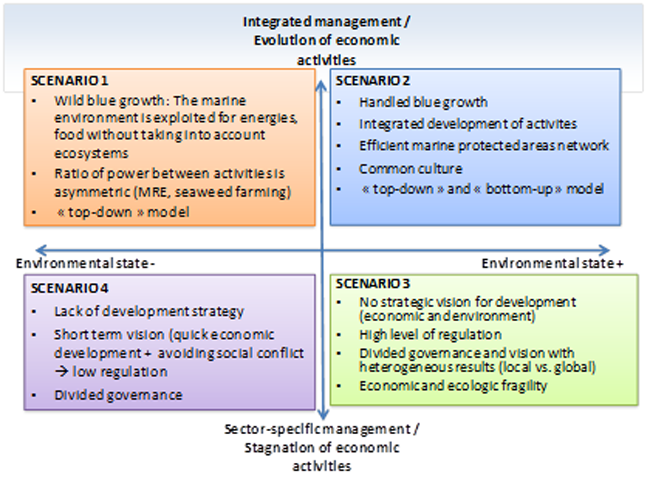 Figure: Summary of the four scenarios developed in the Golfe Normand-Breton case study site
Figure: Summary of the four scenarios developed in the Golfe Normand-Breton case study site
SCENARIO 1
Rapid industrialization to create growth and employment in an economic crisis context
In a context of prolonged economic crisis, the French government has decided to focus on the development of maritime activities, including marine renewables energies and port-related activities, supported by the European political blue growth.
The weakness and fragmentation of governance institutions representing all stakeholders for the marine environment at the Golfe Normand-Breton scale does not allow the introduction of an integrated management plan.
In this context, some activities develop more than others with the support of sector-oriented policies. At the same time, the national application of the Marine Strategy Framework Directive and previous directives (Water Framework Directive) are not implemented sufficiently firmly to detect and/or prevent the degradation of the marine environment.
The degradation of coastal waters pushes aquaculture activities to move offshore and to change their practices albeit with production losses.
This movement and the large areas dedicated to offshore renewable energies contribute to reduce and break up fishing areas. This activity already weakened by environmental degradation and expenses increasing (fuel cost) are in difficulty compared to the strongest economic interests such as marine renewable energies.
At the same time, urbanization is gradually increasingon the coast where local economic interests are considered as a priority over environmental issues.>
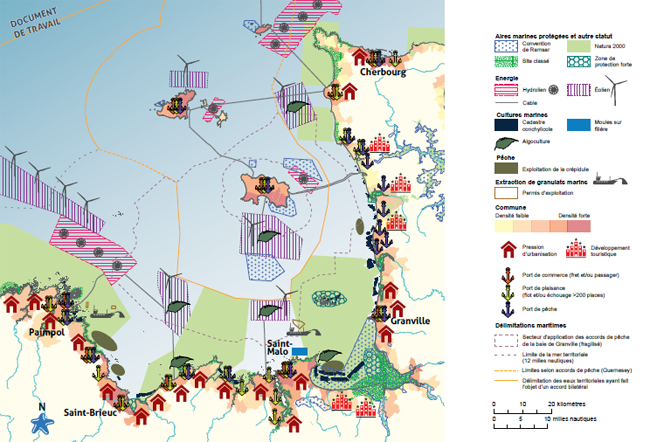
Figure: Visual restitution of the scenario 1 developed in the Golfe Normand-Breton during the VALMER project.
SCENARIO 2
Harmonious development of activities in a protected environment
New activities appear (marine renewable energy, seaweed farming, recreational fishing sector, etc.) and others are changing (offshore aquaculture) with the support of the European Union.
Maritime spatial planning (MSP) enables the administrative simplification of the installation of the new offshore activities while minimizing environmental impacts.
The presence of a Marine Park for the Norman Breton Gulf facilitates the coordination and development of cooperation with the Channel Islands and benefits from the gathering of scientific information that also facilitates decisions.
This type of development requires strong political support and adequate funding (environmental taxes) for the implementation of European Directives (Water Framework Directive (WFD) / Marine Environment Framework Directive (MSFD) / Common Fisheries Policy (CFP)) and compliance with the regulatory framework (Impact Assessment).
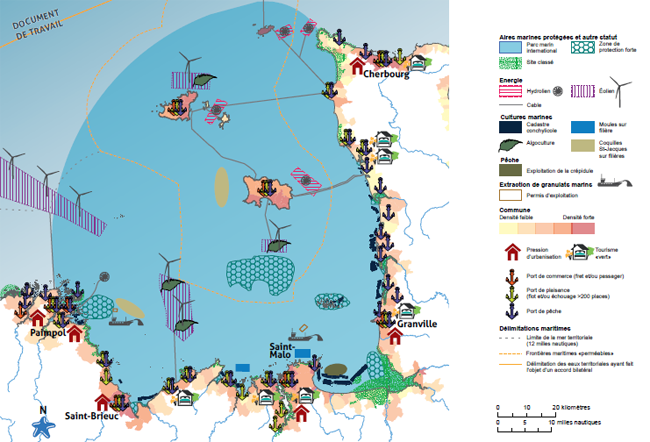 Figure: Visual restitution of the scenario 2 developed in the Golfe Normand-Breton during the VALMER project.
Figure: Visual restitution of the scenario 2 developed in the Golfe Normand-Breton during the VALMER project.
SCENARIO 3
Passive model where the lack of a proactive strategy leads the vigorous en-forcement of environmental policy (seen as a constraint) in a compartmental-ized socio-economic framework
Faced with international pressure and the growing manifestations of the degradation of marine ecosystems, the European Union tightens its environmental policy as well as the pressure on member states to conform. France is forced to achieve its environmental objectives to avoid financial sanctions.
There is a need for quick results: environmental standards are increased in the Golfe Normand-Breton and this makes it more difficult and expensive for the emergence of new activities. The sea is divided between areas with a high level of protection and areas where protection is limited to certain zones, resulting in disparities in the state of the marine environment.
Protective measures are seen as restrictive. In this scenario, cooperation between sectors is done with existing tools (SAGE, SCOT, N2000...) but it remains impossible to develop a common vision on the uses of the sea. This results in an increase of tensions between categories of users and institutional bodies at sea and on the land-sea interface.
Finally we see a delicate balance between maintaining traditional activities and the conservation of the natural environment and the lack of integrated management, giving fertile territory for deep disagreements between users of the sea and of the coast to develop.
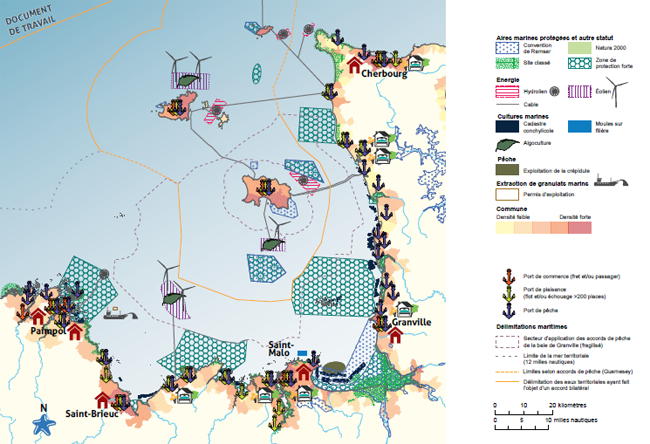
Figure: Visual restitution of the scenario 3 developed in the Golfe Normand-Breton during the VALMER project.
SCENARIO 4
The deliberate ignoring of economic and environmental constraints, driven by short-term view, leads to a gradual degradation of the marine environment and the activities that depends on it
Faced with increasingly strong political and social tensions, the state loses ground on the implementation of conflicting measures including the measures necessary to maintain the quality of the marine environment. This weakness favours short-term interests at the expense of a longer-term strategy. Thus, expensive programmes for the development of EMRs are successively postponed and the development of shale gas is favoured to quickly lower the cost of energy. The decrease in the cost of energy initially makes fishing more viable, economically. However, environment continues to degrade, which eventually impacts on the quantity of fish caught so reducing fishing activity.
In a context of decentralized maritime law enforcement, disengagement of the state, and lowered environmental standards, regions engage in economic development strategies based on mass tourism and coastal urbanization with a lack of waste water management. Given this situation, coastal water quality deteriorates and impacts on the shellfish industry that fails to cope despite attempts to diversify the activity and stop the degradation (direct negotiation with land actors).
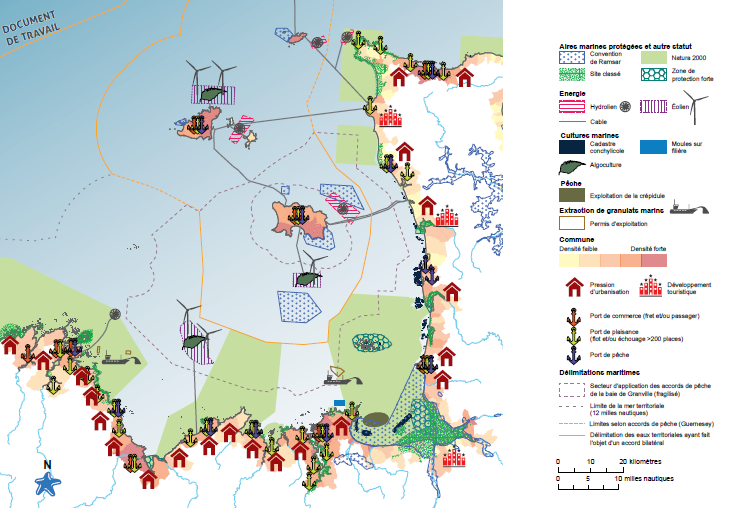 Figure: Visual restitution of the scenario 4 developed in the Golfe Normand-Breton during the VALMER project.
Figure: Visual restitution of the scenario 4 developed in the Golfe Normand-Breton during the VALMER project.

